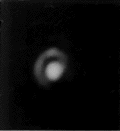
The thermal characteristics of these mirrors enable them to preform well in astronomical applications, as shown in these photos taken with an eight inch diameter OPTICAST mirror in a Newtonian telescope.

| The diffraction spot photo was taken at a temperature of thirty eight degrees Fahrenheit, fourty five minutes after bringing the telescope out from a heated building. The target was a reflection from a polished steel ball at a distance of one hundred feet. |
The thermal expansion coefficient of the material used in these mirrors is several times larger than that of borosilicate glass, but the thermal conductivity of our Astronomical substrates is identical to that of glass. When subjected to sudden forty degree Fahrenheit temperature change in the laboratory, an eight inch diameter Pyrex mirror recovers its figure within minutes, while it is still much hotter than the surrounding air. An eight inch Opticast mirror requires about thirty minutes to recover its figure. However comparison tests between the two mirrors in actual telescopes show little difference in performance for typical operating conditions. This is because the resolving power of the telescope after a sudden temperature change is limited by warm air currents rising off the mirror. The Opticast mirror cools at the same rate as a Pyrex mirror, and both mirrors reach ambient temperature at the same time.